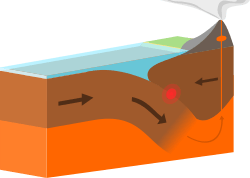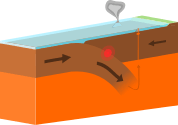Convergent boundary
In plate tectonics, a convergent boundary, also known as a destructive plate boundary, is a region of active deformation where two or more tectonic plates or fragments of the lithosphere are near the end of their life cycle. This is in contrast to a constructive plate boundary (also known as a mid-ocean ridge or spreading center). As a result of pressure, friction, and plate material melting in the mantle, earthquakes and volcanoes are common near destructive boundaries, where subduction zones or an area of continental collision (depending on the nature of the plates involved) occurs. The subducting plate in a subduction zone is normally oceanic crust, and moves beneath the other plate, which can be made of either oceanic or continental crust. During collisions between two continental plates, large mountain ranges, such as the Himalayas are formed. In other regions, a divergent boundary or transform faults may be present.
 Oceanic-continental |
 Continental-continental |
 Oceanic-oceanic |
Mid-ocean ridges
The reason for the existence of convergent boundaries are the mid-ocean ridges that were only beginning to be understood with the acceptance of the theory of plate tectonics in the mid-1960s. The radioactive decay of elements within the rocks in the interior of the earth generates large amounts of heat that moves magma to the surface of the crust in a process called mantle convection. This results in a new oceanic crust or sea floor being formed that slowly moves away from the ridges (sometimes called spreading centers) towards the subduction zones. In other words, new seafloor originates from the upwelling rock as it emerges from the depths of the mantle and it slowly cools as it is transported over the millennia to the collision or subduction zones where it is consumed or recycled.[1]
Subduction zones
Large, shallow earthquakes on subduction zone interfaces are the largest types of earthquakes. They accounted for 90% of the total seismic moment released for the period 1900–1989, but these events usually occur offshore and far from population centers. Non-subduction interface earthquakes also occur in the region of the trench including shallow upper plate shocks, deeper events within the downgoing slab, and events that are related to outer trench swell.[2]
Volcanic arcs
A volcanic arc is formed on the continental plate, above the location of the downgoing oceanic slab. The volcanic arc is the surface expression of the magma that is generated by hydrous melting of the mantle above the downgoing slab. Hydrated minerals (e.g., phlogopite, lawsonite, amphibole) within the oceanic lithosphere become unstable at certain depths due to increased temperature and pressure, causing the crystal structure of the hydrated minerals break down and release water. The buoyant fluids then rise into the asthenosphere, where they lower the melting temperature of the mantle and cause partial melting. These melts rise to the surface and are the source of some of the most explosive volcanism on Earth because of their high volumes of extremely pressurized gases.
When two plates with oceanic crust converge, they typically create an island arc as one plate is subducted below the other. The arc is formed from volcanoes which erupt through the overriding plate as the descending plate melts below it. The arc shape occurs because of the spherical surface of the earth (nick the peel of an orange with a knife and note the arc formed by the straight-edge of the knife). A deep oceanic trench is located in front of such arcs where the descending slab dips downward, such as the Mariana Trench near the Mariana Islands.
Back arc basins
Some convergent margins have zones of active seafloor spreading behind the island arc, known as back-arc basins. When one plate is composed of oceanic lithosphere and the other is composed of continental lithosphere, the denser oceanic plate is subducted, often forming an orogenic belt and associated mountain range. This type of convergent boundary is similar to the Andes or the Cascade Range in North America.
Oceanic trenches
An oceanic trench is found where the denser plate is subducted underneath the other plate. There is water in the rocks of the oceanic plate (because they are underwater), and as this plate moves further down into the subduction zone, much of the water contained in the plate is squeezed out when the plate begins to subduct. However, the recrystallization of ocean floor rocks, such as serpentinite, which are unstable in the upper mantle, recrystallize into olivine, causing dehydration through loss of hydroxyl groups. This addition of water to the mantle causes partial melting of the mantle, generating magma, which then rises, and which normally results in volcanoes. This normally happens at a certain depth, about 70 to 80 miles below the Earth's surface, and so volcanoes are formed fairly close to, but not right next to, the trench.
Examples
- The collision between the Eurasian Plate and the Indian Plate that is forming the Himalayas.
- The collision between the Australian Plate and the Pacific Plate that formed the Southern Alps in New Zealand
- Subduction of the northern part of the Pacific Plate and the NW North American Plate that is forming the Aleutian Islands.
- Subduction of the Nazca Plate beneath the South American Plate to form the Andes.
- Subduction of the Pacific Plate beneath the Australian Plate and Tonga Plate, forming the complex New Zealand to New Guinea subduction/transform boundaries.
- Collision of the Eurasian Plate and the African Plate formed the Pontic Mountains in Turkey.
- Mariana Trench
- Subduction of the Juan de Fuca Plate beneath the North American Plate to form the Cascade Range.
See also
References
- ↑ Bolt, B. (2005), Earthquakes: 2006 Centennial Update – The 1906 Big One (Fifth ed.), W. H. Freeman and Company, pp. 146–150, ISBN 978-0716775485
- ↑ Yeats, R. S.; Sieh, K. E.; Allen, C. R. (1997). The Geology of Earthquakes. Oxford University Press. pp. 371–378. ISBN 978-0-19-507827-5.

